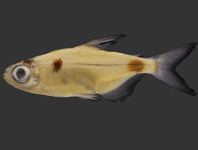Abstract
The extinct hemipteran family Scytinopteridae, the presumed ancestors of the Heteroptera, was a small but widely distributed element of the Triassic insect fauna of Queensland. A total of 28 tegmina have been collected at six sites (Gayndah, Esk, Mount Crosby, Riverview, Denmark Hill and Dinmore) in five Middle or Late Triassic Formations. The specimens are remarkably uniform in both wing shape and basic venation, and the generally weakly developed venation of the apical area of the tegmen is rarely clearly preserved. Some consistent variations in tegmen size and in minor venational characters, however, have enabled the identification of six and possibly seven species in three genera, acknowledging of course, the somewhat artificial nature of fossil insect species based solely on isolated wings. Mesoscytina Tillyard, 1919 (= Triassoscarta Tillyard, 1919, syn. nov.), comprising Mesoscytina australis Tillyard, 1919 (= Mesoscytina affinis Tillyard, 1919, syn. nov., = Triassoscarta subcostalis Tillyard, 1919, syn. nov.) (Denmark Hill, Esk), Mesoscytina fistulae sp. nov. (Mount Crosby, Gayndah), Mesoscytina woodsi sp. nov. (Gayndah), and Mesoscytina magna sp. nov. (Dinmore), is distinguished by the combination of the R more or less straight distally and M with three apical branches. The monotypic Eurymelidium Tillyard, 1919, with type species Eurymelidium australe Tillyard, 1919 (Denmark Hill, Dinmore), has R sinuous and M with two apical branches, and the monotypic Apheloscyta Tillyard, 1922, with type species Apheloscyta mesocampta Tillyard, 1922 (Denmark Hill, Riverview) has R more or less straight and M with two apical branches. Three poorly preserved and thus unidentifiable scytinopterid tegmina from Esk, similar in size to Mesoscytina fistulae, are designated as Esk species A.
References
Denmead, A.K. (1955) The West Moreton (Ipswich) Coalfield. Geological Survey of Queensland Publication, 279, i–vi, 1–114, plus a folder of maps.
Evans, J.W. (1963) The systematic position of the Ipsviciidae (Upper Triassic Hemiptera) and some new Upper Permian and Middle Triassic Homoptera from Australia (Insecta). Journal of the Entomological Society of Queensland, 2, 17–23.
http://dx.doi.org/10.1111/j.1440-6055.1963.tb00384.xJell, P.A. (2004) The fossil insects of Australia. Memoirs of the Queensland Museum, 50, 1–124.
Jell, P.A. & Lambkin, K.J. (1992) Middle Triassic orthopteroid (Titanoptera) insect from the Esk Formation at Wivenhoe Dam. Memoirs of the Queensland Museum, 33, 258.
Lambkin, K.J. (2015) Revision of the Dysmorphoptilidae with emarginate tegmina (Hemiptera: Auchenorryncha: Cicadomorpha: Prosboloidea) of the Queensland Triassic. Zootaxa, 3936 (3), 357–374.
http://dx.doi.org/10.11646/zootaxa.3936.3.3Martins-Neto, R.G., Gallego, O.F. & Melchor, R.N. (2003) The Triassic insect fauna from South America (Argentina, Brazil and Chile): a checklist (except Blattoptera and Coleoptera) and descriptions of new taxa. Acta zoologica cracoviensia, 46, 229–256.
Purdy, D.J. (2013) Esk Basin. In: Jell, P.A. (Ed.), Geology of Queensland. Geological Survey of Queensland, [Brisbane], pp. 387–391.
Purdy, D.J. & Cranfield, L.C. (2013) Ipswich Basin. In: Jell, P.A. (Ed.), Geology of Queensland. Geological Survey of Queensland, Brisbane, pp. 391–396.
Raven, R.J., Jell, P.A. & Knezour, R.A. (2015) Edwa maryae gen. et sp. nov. in the Norian Blackstone Formation of the Ipswich Basin—the first Triassic spider (Mygalomorphae) from Australia. Alcheringa, 39, 259–263.
http://dx.doi.org/10.1080/03115518.2015.993300Shcherbakov, D.E. (1984) Systematics and phylogeny of Permian Cicadomorpha (Cimicida and Cicadina). Paleontological Journal, 1984 no. 2, 87–97.
Shcherbakov, D.E. (1996) Origin and evolution of the Auchenorrhyncha as shown by the fossil record. In: Schaefer, C.W. (Ed.), Studies on Hemipteran Phylogeny. Entomological Society of America, Lanham, Maryland, pp. 31–45.
Shcherbakov, D.E. (2000) Permian faunas of Homoptera (Hemiptera) in relation to phytogeography and the Permo-Triassic crisis. Paleontological Journal, 34, 251–267.
Shcherbakov, D.E. (2002) The 270 million year history of Auchenorrhyncha (Homoptera). Denisia, 4, 29–35.
Shcherbakov, D.E. (2011) New and little-known families of Hemiptera Cicadomorpha from the Triassic of Central Asia—early analogs of treehoppers and planthoppers. Zootaxa, 2836, 1–26.
Shcherbakov, D.E. & Popov, Y.A. (2002) Superorder Cimicidea Laicharting, 1781 Order Hemiptera Linné, 1758. The bugs, cicadas, plantlice, scale insects, etc. (=Cimicida Laicharting, 1781, = Homoptera Leach, 1815 + Heteroptera Latreille, 1810). In: Rasnitsyn, A.P. & Quicke, D.L.J. (Eds.), History of Insects. Kluwer Academic Publishers, Dordrecht, pp. 143–157.
Tillyard, R.J. (1919) Mesozoic insects of Queensland. No. 7. Hemiptera Homoptera; with a note on the phylogeny of the Suborder. Proceedings of the Linnean Society of New South Wales, 44, 857–896.
Tillyard, R.J. (1922) Mesozoic insects of Queensland. No.9. Orthoptera, and additions to the Protorthoptera, Odonata, Hemiptera and Planipennia. Proceedings of the Linnean Society of New South Wales, 47, 447–470.
Woods, J.T. (1962) Fossil plants and insects from near Gayndah. Unpublished Report of the Geological Survey of Queensland, Brisbane, 1 pp.

